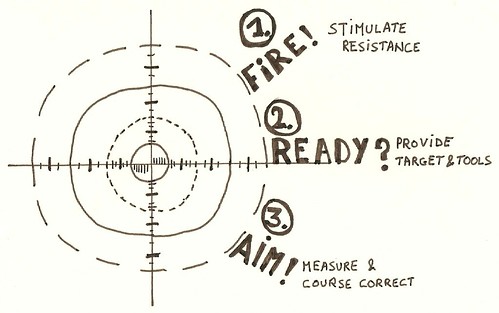It’s not a joke: painting a bull’s-eye on your deliverables is your first job if want to succeed with people who don’t report to you.
When I just started this series I was exaggerating a bit in order to get m point across that gamers are not a ‘lost’ generation. However, after four articles the evidence starts piling up. There is a game layer on top of our world and acknowledging the game dynamics in our daily life may well be a key to saving our economy.
Let me explain how this translates into my world. In organizational change management we often have to deal with resistance. At least, that is how we label it. But what would happen if I would relabel resistance as a dynamic that defines the game? How would I play the cards? What would be the playing field? How would I redefine ‘success’ and ‘failure’ in this case?
The Game Dynamics of Organizational Change Management
The most powerful game dynamic I posses is something I found out by hitting my head against the wall of resistance several times. Like in a computer game I had to trial-and-error my way through resistance, only to discover that you can’t change the cards that you are being dealt, only how you play the hand.
Take for example Sebastian, a colleague of mine who is running the Master Data cleaning part of a large-scale project. He depends on other people’s input and committment for the quality of his own work. If they screw up Sebastian will be blamed. It gets even worse when you realize that he has no hierarchical power over the people who need to get the master data cleaning done. So why would they care?
If Sebastian plays the Authority game he will lose it. He needs to aim for a different game and redefine the dynamic he is up against. This new game is called “Fire – Ready -Aim”:
1. FIRE!
Here is the game situation: the data cleansers need to be guided through their change cycle, (denial, anger, bargaining, depression, acceptance) but at the same time the work needs to get done. The solution is to combine both and to nudge them with a series of deliverables that people can shoot at, nicely ordered in the same direction: forward.
The dynamic we are after is what Edgar Schein calls Diagnostic Interventions. By asking people for their involvement, you also begin to influence their thinking. For example, once you are conducting a survey, you have influenced the thinking and expectations of the people you are surveying.
So the point is to suspect yourself first. You are the foreign element in the room. Once people are aware of your existence and your assignment, you start to influence their behavior and reactions. Like it or not. If you get that, you are already halfway.
2. READY!
Then comes a simple trick but no fun. It goes against your intuition and it sets your ego on fire. The point is to reengineer all of your deliverables so they allow full collaboration.

The hard part:
- It means downgrading the built-in look-how-great-I-am- intelligence;
- It requires you to chop your deliverable down in chunks that the customer can swallow;
- It means you have to let the customer tinker with the deliverable, take it apart and move it forward;
- It means your prototype will be improved by the customer;
- Ultimately, it means that you will not be the most intelligent person in the room at the end of the day: the community is!
In short, you need to know that co-creation of the deliverables is the first step to ownership. Being aware of this will improve your deliverables so they allow for co-creation. In the case of master data cleansers this may mean providing them with the tools to track the progress etc.
3. AIM!
People make sense of the change as they react to the prototype of your deliverables. This will get their minds in motion and their noses pointed in the direction of the change. Sense making is a process that requires you to build a platform of psychological safety (knowing that it is OK to step out of an old habit and to try something new).
The point here is to listen, listen and listen because the cause of major setbacks is due to going faster than the speed of making sense.
Elegant Organization
The “Fire – Ready -Aim” approach requires you to paint a bull’s-eye on each of your deliverables, because people will be tempted to shoot when they see one. If they shoot, two things will happen at the same time:
- People will make your deliverable move in the right direction: forward;
- People will automatically take ownership of the deliverable and start to take care of it.
It’s dangerous to conclude that you can just throw about any unfinished deliverable at people’s heads to provoke a reaction.
Try it. You will soon find out that people have a bullshit-detector and will only accept the very best of your efforts to accommodate their needs. This is what Jeff Jarvis calls elegant organization: you don’t create a community but provide elegant organization and then the community will let you help them.



